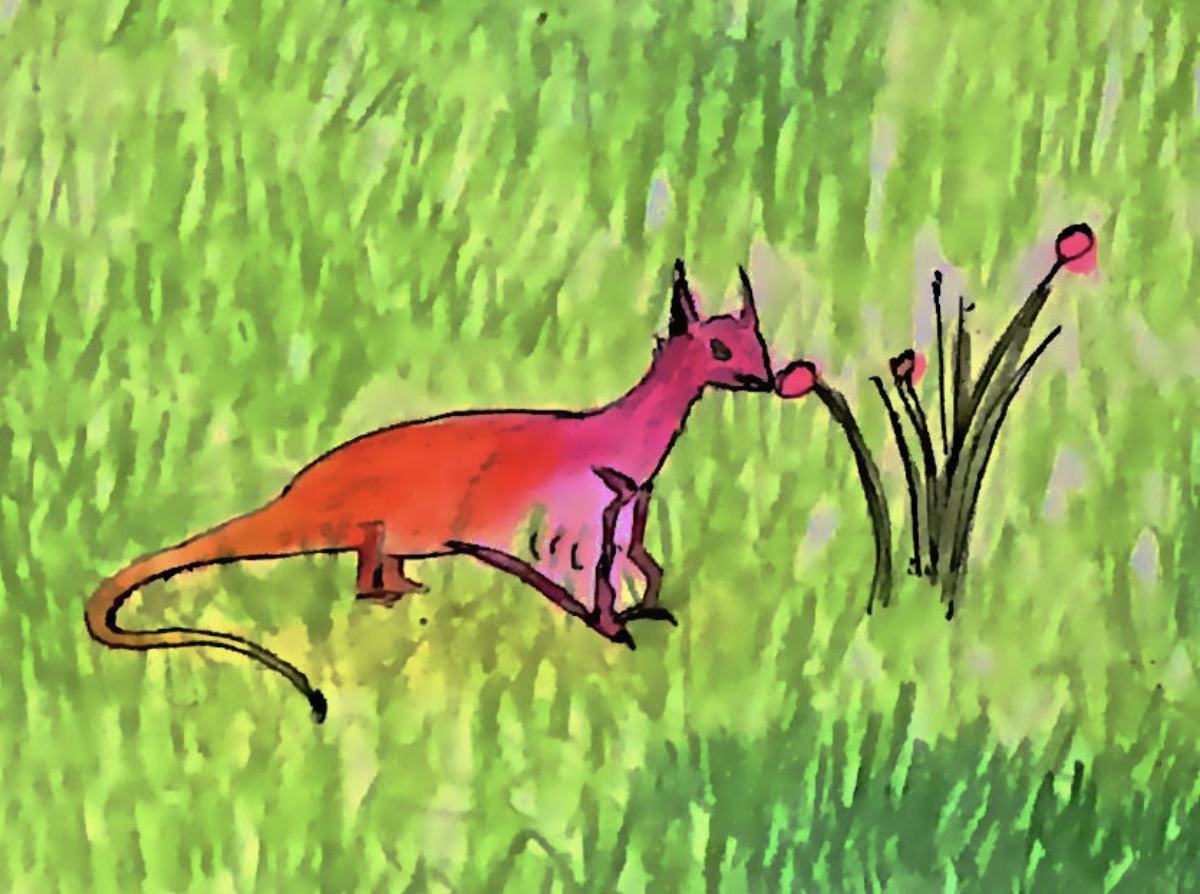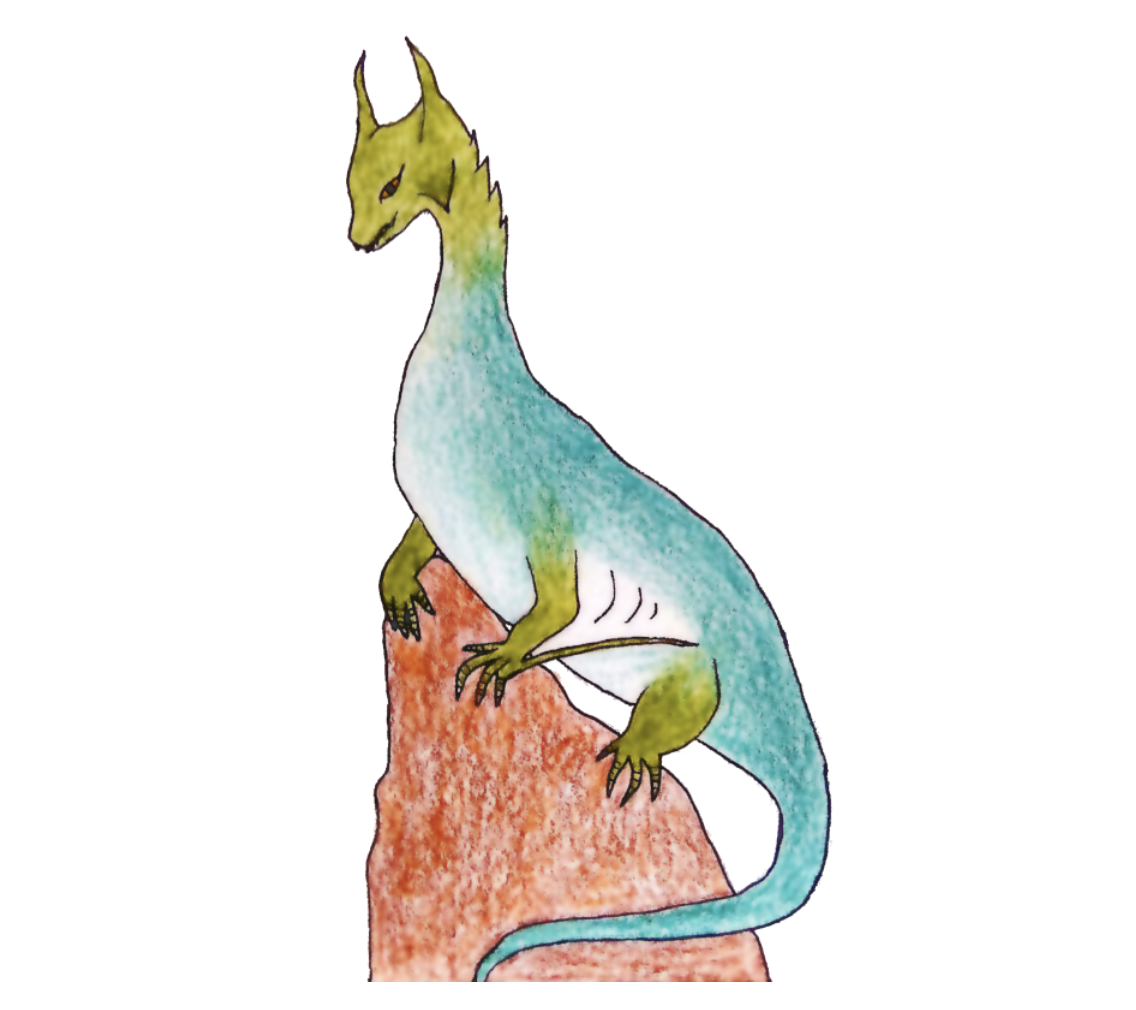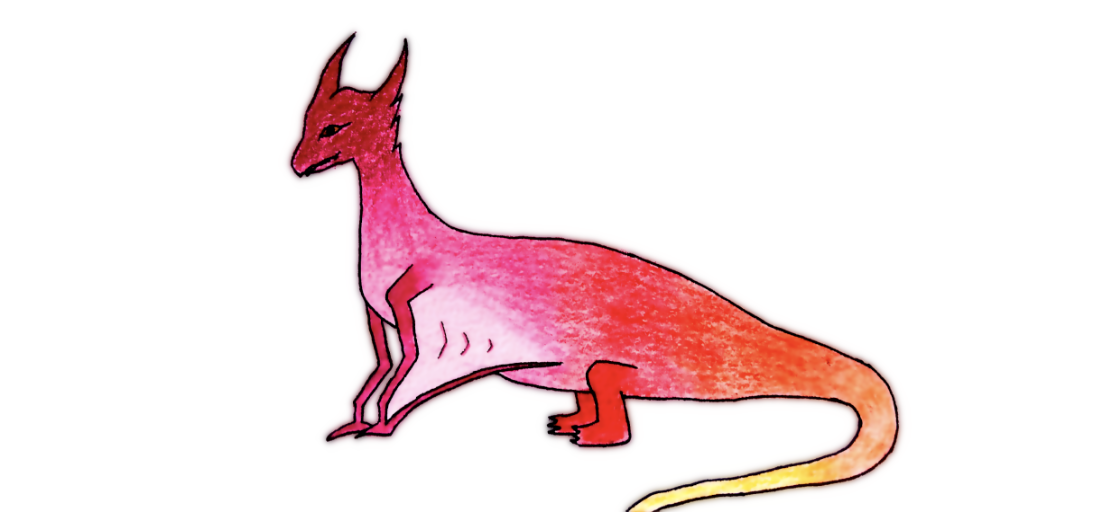Darwin and Dragons
How to make a dragon in just a few (hundred million) short years

How to make a dragon in just a few (hundred million) short years
Biologically speaking, dragons are surprisingly plausible. They may have weird diets, but they wouldn’t necessarily break the laws of physics. Over the past few articles, we’ve gone over how they could fly, produce fire, and fireproof themselves. We’ve touched on how dragons could use those adaptations, and where they would live. So, is the case closed? Could dragons happen?
Before we can answer that, we have to talk about evolution.
Unlike other Snipette pieces, this one involves quite a bit of math and biochemical equations. If you want to skip these sections, feel free to use the "math-free" toggle below or watch out for icons on the sides of the paragraphs:
This is the last of a five-part series on the evolution and biology of (hypothetical) dragons. Each part is a self-contained unit, so you could either read them all or simply dive in where you like.
All the anatomical and physiological features we’ve discussed so far are aspects of a dragon’s phenotype. Phenotypes are the observable characteristics of an animal, like the strong wings and special fuel sac we attributed to our Skyflame. However, evolution doesn’t plan ahead to imagine organisms with beneficial phenotypes. No creature ever thought to itself, “Oh, big wings will be useful one day, won’t they? I’ll get to work growing some.”
All the inner workings of the dragons we’ve discussed so far are aspects of the animals that you see now—the strong wings, for example, or the special gas sac on the Skyflame's inside. But where did those wings first come from? Evolution doesn’t plan ahead to say that “Let me develop some small useless flaps that will grow into something useful later.”
Evolution results from a series of small, random mutations. If a mutation is beneficial, the organism carrying it is more likely to pass on its genes. If the mutation is harmful, the organism is less likely to pass on its genes. Because of this natural selection, each step on the path to an eventual draconic phenotype must be immediately advantageous. It isn’t enough for the eventual flying and firebreathing phenotype to be useful. Each incremental evolutionary step a proto-dragon takes must be immediately useful (or at the very least not harmful) for it to persist.
Evolution is the result of small, random mutations. At the DNA level, the “how to make you” instructions are being copied from your parents—but that copying isn’t flawless. Some mistakes or ‘mutations’ happen which make the copy less exact. And, if you’re very, very lucky, those mutations will end up being helpful.
People with helpful mutations are more likely to survive than people without them (and much more likely to survive than people with harmful mutations). This means that, over time, all the helpful mutations will add up. The catch? Evolution won’t keep mutations that are helpful only three steps into the future. Every mutation has to be beneficial right here, right now—and it has to carry on that way for every step of the way.
This fact begs the question: What’s practical about a small increase in gas production that could eventually give rise to a living flamethrower? How would producing acetic acid be useful enough for the trait to stick around until a proto-dragon species managed to ignite it? These are the questions we have to keep in mind as we take a quick stroll through hypothetical history.
We’ll begin our journey with a species of small, flightless reptiles. These tiny creatures don’t look all that impressive, but like the ancestors of pterosaurs, they’re highly nimble with keen eyesight. They can also quickly swivel their heads to react to stimuli. These are the ancestors of our Graphene-Crested Skyflames.

The first proto-Skyflames aren’t much of a match for larger predators, but they do have a secret weapon. They can collect and expel the gases they create during digestion. These include methane and sulphur dioxide. This adaptation is useful for deterring predators with nasty odours. Think skunks, but the stink comes out of their mouths.
While they perfect not becoming food, proto-Skyflames also evolve to be better at getting it. Mutations arise to give them a stronger bite force, which helps them chew tough food.
This bite is so strong that the proto-Skyflames often end up scraping their teeth. To combat wear and tear, their teeth evolve to be tougher and stronger. Through further random mutation, their ability to belch large amounts of methane combines with their ability to scrape their teeth together.
Finally, the proto-Skyflames develop an instinct to heat the methane leaving their mouths by scraping their teeth. This behaviour ignites the methane, creating small flashes beyond their teeth that are even more useful, for deterring predators, than simple gas expulsion would be.
Even though the flashes they’re creating at this point are small and happen outside their bodies, proto-Skyflames experience a selective pressure to adapt and avoid burning themselves. Selective pressures are environmental factors that make certain adaptations favourable when they arise. For proto-Skyflames, the fiery selective pressure leads to adaptations for producing natural aerogel on and within themselves.
This aerogel blocks the flow of heat and fireproofs the proto-Skyflames. Over time, they become fireproof enough to safely ignite methane inside their mouths. They even evolve hard plates in their throats, which they scrape together to ignite their methane where it’s most condensed.
Around this time, the proto-Skyflames also begin to cultivate microbes in their bodies that feed on carbon monoxide, a toxic byproduct of combustion. The microbes feed on this carbon monoxide and convert it into methane and carbon dioxide, both of which are relatively harmless. This adaptation protects the proto-Skyflames from the harmful effects of any carbon monoxide they inhale after a fire attack.
As their fire attacks get stronger, they have to deal with more carbon monoxide. Thus, they experience strong selective pressure to support more of these carbon-monoxide-eating microbes.
Though evolution doesn't know it yet, this adaptation will become especially useful once the proto-Skyflames start producing methanol.
Over time, proto-Skyflames begin to run faster so they can escape any fires they accidentally set warding off predators. To that end, they develop stronger, more efficient muscles.
Just like the real-life ancestors of pterosaurs, these proto-Skyflames eventually evolve powered flight. They do so as a means of evading fires better. Their strong and efficient muscles make it so they can carry larger loads than other flying creatures their size, so they evolve to be bigger. Increased size makes it easier for them to fight off predators who aren’t scared away by their flash defence.
The muscles around their gas sacs also become stronger, allowing them to compress methane further and pack more of it into the same volume. This adaptation allows for more powerful fire attacks with a larger range.
Now that they can fly, the proto-Skyflames can afford to use more powerful fire attacks, whereas, on the ground, it would be harder for them to escape any fires they set. At this point, the proto-Skyflames have moved up the food chain to become apex predators. They prey on large animals like bison on prairies, even capturing some alive to harvest more methane. They also learn how to hunt with fire on prairies most effectively, i.e. covering a large area, not burning the land too often, and influencing grazing behaviours.
The move to prairies wasn’t a deliberate one. Proto-Skyflames used their Quetzalcoatlus-like flight to migrate to many biomes, and those who settled on and around prairies found themselves at an evolutionary advantage to their peers because of the fire-resistant nature of grasslands.
Next, proto-Skyflames evolve to produce graphene within their gas sacs to better stand up to the pressures they’re put under. This adaptation allows the proto-Skyflames to compress methane even further, which in turn lets them store more in a tight volume and expel it faster. Another set of mutations to dope the graphene with iron leads to the proto-Skyflames finally producing methanol, a more convenient and effective fuel source than methane.
Sadly, large quantities of methanol prove toxic to proto-Skyflames. Many that develop the iron-doping trait die out once their methanol production exceeds the safe limit, but a lucky few obtain another adaptation that allows them to produce fomepizole. This chemical inhibits the metabolization of methanol and renders the proto-Skyflames relatively immune to methanol poisoning.
One final set of mutations for a second gas sac that expels carbon dioxide to better eject methanol and our proto-Skyflames finally evolve into true methanol-spewing Graphene-Crested Skyflames.
Acidic Wildflowers have a similar starting place to Skyflames. They too evolve from flightless reptiles. These proto-Wildflowers are omnivorous and consume lots of sugary, acidic, and fermented fruits, which are rich in acetic acid bacteria.
Acidic Wildflowers have a similar starting place to Skyflames. They too evolve from flightless reptiles. These proto-Wildflowers are omnivorous and consume lots of sugary, acidic, and fermented fruits, which are rich in acetic acid bacteria.
These bacteria find the digestive tracts of the proto-Wildflowers highly favourable because of their diets, so they begin to populate it. Through horizontal gene transfer, the proto-Wildflowers obtain acid resistance from the acetic acid bacteria living inside them. This trait allows them to consume even more acidic food without worrying about the acid irritating their bodies. This is a great adaptation because it keeps the proto-Wildflowers well-nourished and lets them digest foods that other animals won’t touch due to their acidity.
This is where we find what’s known as preadaptation, where traits previously selected for one function end up being used for another. Proto-Wildflowers evolved acid resistance to increase their foraging options, but now they can also build up acetic acid reserves in their bodies. This acetic acid is made by the acetic acid bacteria within them, and it makes them unappetizing to predators.
This is where we find what is known as ‘preadaptation’. Proto-Wildflowers evolved acid resistance so they could have more options for food. But now, they could also build up a reserve of acid in their bodies, making themselves unappetizing to predators who couldn’t handle so much acid. What started out as a way to get more food was now also helping them not become food themselves.
Eventually, the proto-Wildflowers begin spewing acetic acid at predators to irritate their eyes and skin, thereby driving them away.
Like the proto-Skyflames, the proto-Wildflowers evolve a teeth-scraping behaviour to help them chew tough foods. They also evolve to be warm-blooded like pterosaurs as their metabolisms speed up to allow them to climb more trees and eat more sugary fruits. This warm-bloodedness, coupled with a sudden mutation that lets them produce acid-decomposing enzymes, allows them to trigger the thermal decomposition of the acetic acid in their bodies, breaking it down into gaseous methane and ketene.
Using their pre-existing scraping behaviour, the proto-Wildflowers learn to ignite this flammable gas mixture in the air outside their mouths and produce small flashes. These flashes serve as a warning sign to predators, saying “I’m full of deadly acid! Don’t eat me!” Proto-Wildflowers also develop bright colour patterns to warn predators of their toxicity, much like real poisonous animals.

The flashes of fire, though tiny, do pose a slight danger to proto-Wildflowers. This creates a selective pressure for them to evolve fire resistance, just like their Skyflame counterparts. Afterwards, they evolve to use their flashes to ignite the acetic acid they spew, because what’s worse than getting hit with acid? Getting hit with flaming acid.
At this point, the proto-Wildflowers begin to evolve flight for the same reason our Skyflames did: avoiding their own fires and hunting more effectively. They too move to prairies — their optimal hunting grounds — and begin consuming large amounts of wildflowers in order to sustain their acetic acid bacteria.
If wildflowers weren’t enough, the large flight range we established for them would allow them to travel regularly from prairies to regions with a greater abundance of sugary and acidic foods to fuel up. They could also supplement their acetic acid bacteria needs by eating soil, or they could simply prey on animals that consume sugary and acidic foods themselves. Voilà! We have our Acidic Wildflowers at last.
Bringing this back to the question of whether dragons could exist, I’d say the evolution of real dragons is improbable but not impossible. Many of the adaptations required for dragons to exist have never been observed in nature, and their emergence would require countless environmental factors to align perfectly over millions of years.
What’s more, certain biophysical constraints — like the peak efficiency and endurance of muscles, the nutritional needs of methane-producing microbes, the efficiency with which microbes can convert carbon monoxide to safer compounds, the limits of acid resistance, and the volatility of fuel — could prevent real dragons from rising to the magnificence of even their most conservative fictional depictions.
Nevertheless, knowing the basics of how these animals might evolve has made me appreciate them even more. They test the boundaries of what nature can achieve and stand as a testament to the limitlessness of human imagination.
What’s next? This is the last of a five-part series on the (hypothetical) science and natural history of dragons. You can find the full series here.